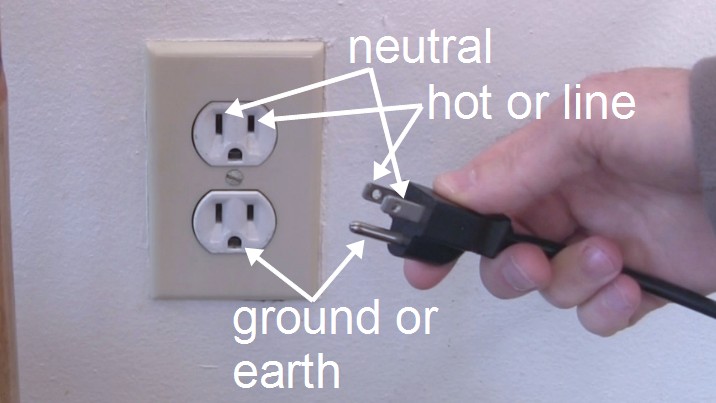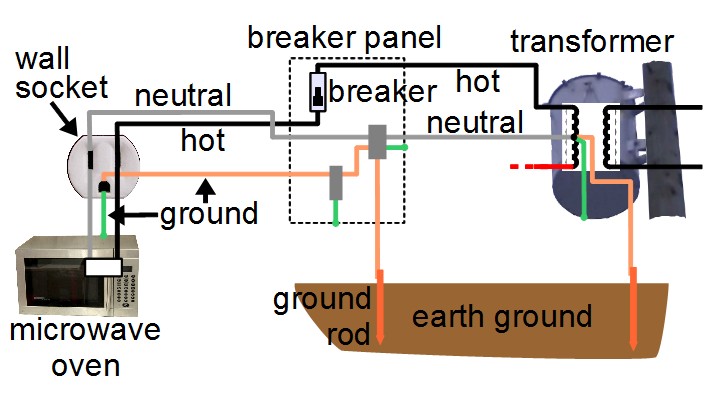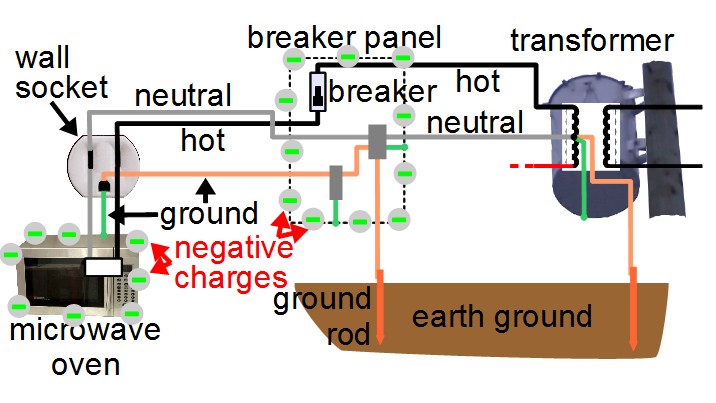What is ground - household
Just what is the ground? The wall sockets that you plug things in to every day has a ground hole and most plugs have a third prong called the ground prong -- just what is that for? That's what I'll explain here. Note the I'll explain it for North America and there are some differences throughout the world.

Below is a diagram of what goes on behind that wall socket. The wall socket is on the left and has a microwave oven plugged into it. But we'll start on the right at the transmission pole outside the building. On that pole is a transformer and it's that transformer that gets power from the power lines going all the way back to a generation system somewhere.

The black wire is called hot, or line, and goes from the transformer to a breaker in your breaker panel. From there it goes to the shorter of the two rectangular holes in the wall socket. Since the microwave oven is plugged into it, there's a black hot in the power cord that goes to the microwave oven's electronics.
From the microwave oven electronics, the return path is a white wire called neutral (grey in the diagram). That goes back to wall socket to the taller of the two rectangular holes. From there it continues to the breaker panel and then to the transformer on the transmission pole.
The electricity that powers the microwave oven is in that set of hot and neutral wires.
So where does the ground hole in the wall socket and ground prong on the plug get involved? It actually starts at the breaker panel where it's connected to the neutral wire. In the diagram it's the brown and green wires. From there it goes to the roundish shaped hole in the wall socket, which is what the ground prong on the plug goes into. That continues to the microwave oven where it's connected to the microwave oven's metal case.
Other things also have ground wires. For example, the metal case of the breaker panel has a ground wire connected to it that goes down to a ground rod that's plunged into the actual earth ground. In fact, in the breaker panel, the neutral and the ground going to the wall socket are also connected to the breaker panel's case and hence are also connected to the wire going to earth ground. And lastly, the transformer also has a ground wire going to a ground rod in earth ground.
Why is the ground wire connected to the microwave oven's case? As shown in the diagram below, let's say that somewhere in the microwave oven the insulation on the hot wire get's damaged and the now exposed copper wire inside touches the metal case, called a short circuit. That's the brown exposed section of the black hot wire touching the case. You can see in the photo insert what the exposed copper would look like. That means the metal case is now an extension of the hot wire.

But, since the ground wire is connected to the case, an electrical circuit has now been formed between the hot wire, the metal case, the ground wire going back to the breaker panel where both the ground wire and the neutral are connected together in some way, from there along with neutral to the transformer, back from the transformer along the hot, through the breaker in the breaker panel and back to the microwave oven's case. Notice that the microwave oven's electronics aren't even involved and so the oven doesn't even have to be turned on.
The transformer sees a closed circuit and electricity flows. But there's enough electrical current to cause the breaker that the hot wire passes through to trip, meaning it opens, and stops the flow of electricity. Everything is safe again until you fix the problem and flip the breaker back on. As an example, in many case these breakers are rated for 15 amps, meaning there has to be 15 amps of current before they will trip.Why is it important that the breaker stops the flow of electricity? To understand that, look at the diagram below to see what could happen if there was no ground wire connected to the case. If, once again, the copper was exposed on the hot wire and you touch the metal case then electricity could go from the hot wire, through the case, through you and to the ground you're standing on. From there it continues back to one of the ground rods and closes the circuit as before.

However, this time the high resistance of the ground prevents the current from getting high enough to trip the breaker. Instead it's in the milliamps range somewhere. At 16 milliamps, you can't let go. At 20 milliamps your respiratory muscles are paralized -- you can't breath, at 100 milliamps your heart goes into ventricular fibrillation. Hopefully, though, it's below 20 milliamps and you only feel a slight buzzing, enough to tell you that you should immediately unplug the microwave oven and find and fix the problem.
You can see why it's a bad idea to cut off the ground prong from a plug, often done because people have an extension cord with only two holes in the sockets.
The other problem - charge buildup
So why to we have these ground rods pounded into the ground? One reason is in case there's a dangerous or annoying buildup of electrical charge on a metal case, as shown in the diagram below. If you were to touch the case, you'd get a shock. Notice in the diagram that the breaker panel has a ground wire connected to it going to a ground rod. You can also follow the path of the ground wire from the microwave oven's metal case to the breaker panel and from there to that same ground rod.

If there's a lightning strike nearby then it could cause charge to build up on the metal cases and when you touch them, you'd get a shock. The earth is a very big object that's a poor electrical conductor, but it's enough of a conductor to matter. It also has an overall neutral electrical charge, neither positive nor negative. If a metal case somehow acquires a negative charge for example, then it's going to be more negative than the earth that it's connected to. This charge imbalance will cause the negative charge to flow until everything has an even charge again. And since the earth is so large, it can take pretty much all that negative charge and still be largely neutral. And once that's done, the case is neutral too, it's no longer charged and is harmless to touch again.
Video - What is Ground? Earth Ground/Earthing
The following video takes you through all of the above.
